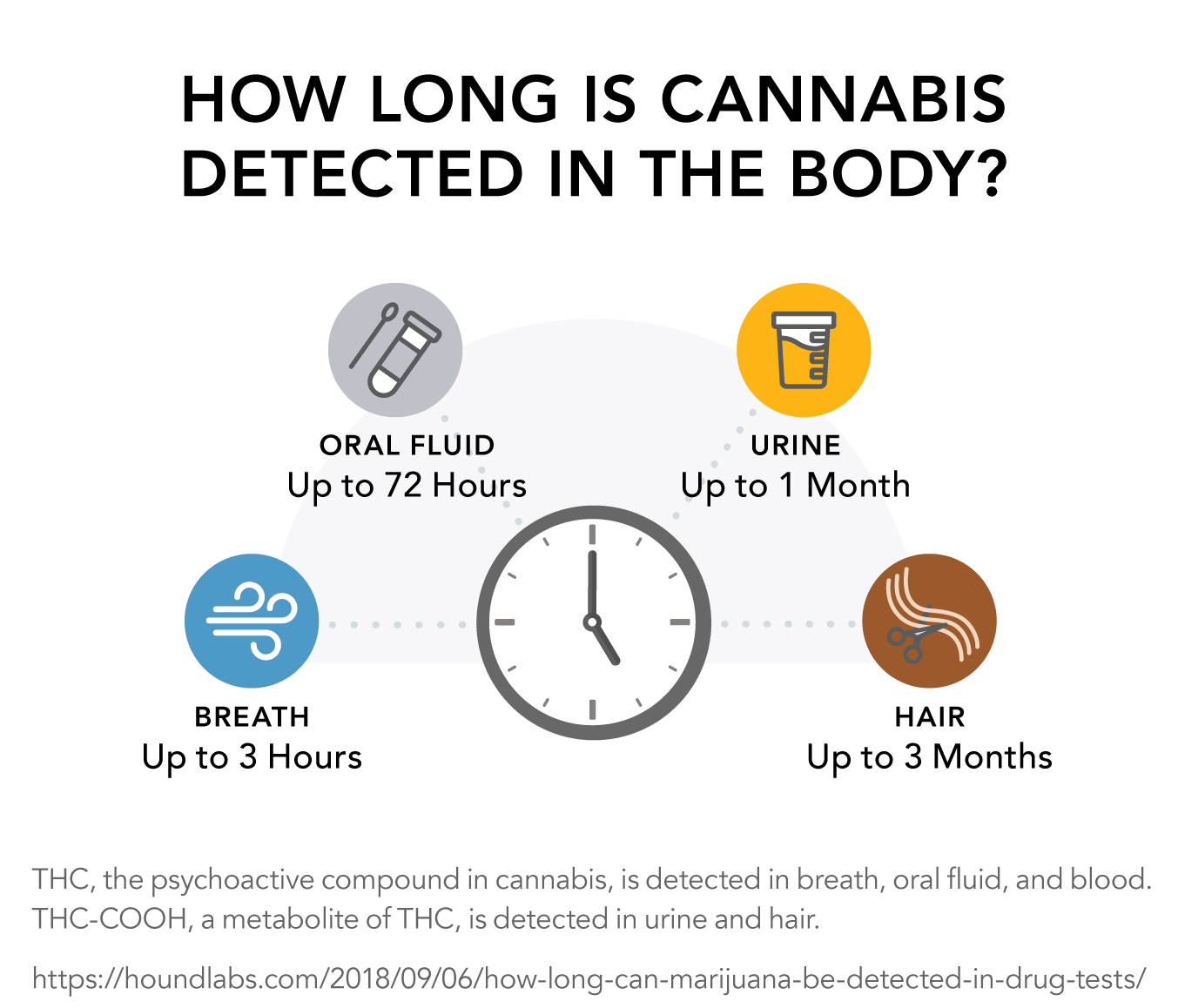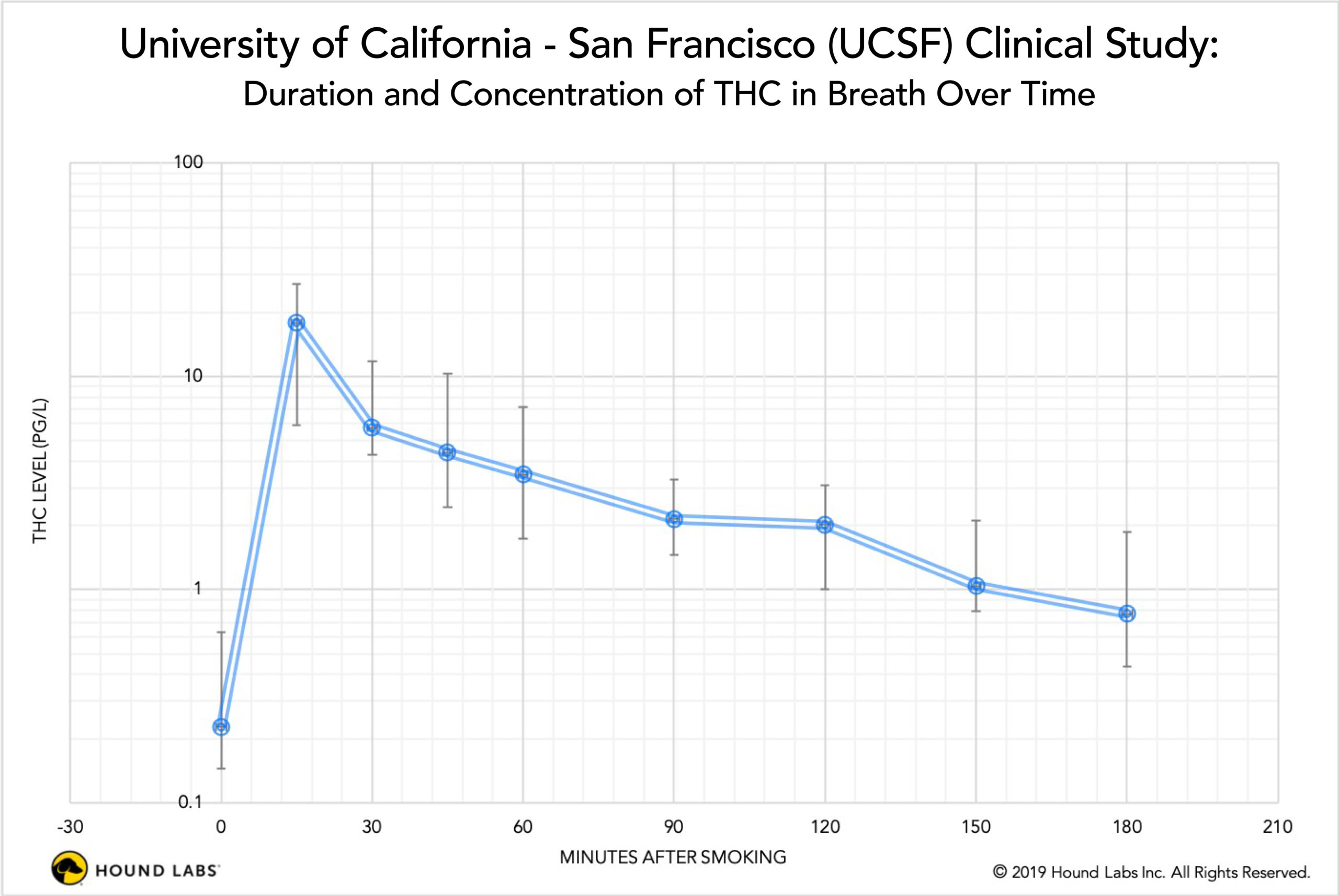Why Is Low THC Measurement Important?
THC (the psychoactive compound in cannabis) degrades very quickly in breath to concentrations below 2 parts per trillion. Hound Labs invented new technology to create a tool with the ultra-sensitivity required for THC measurement in breath.
Ultra-Sensitivity Studied by UCSF
During clinical studies, scientists at the University of California, San Francisco (UCSF) clinical toxicology lab confirmed the sensitivity of the HOUND® CANNABIS BREATHALYZER. To validate the extreme sensitivity and ability of the HOUND® BREATHALYZER to measure THC, the UCSF research team developed a new protocol to study baseline THC levels with sub-picogram sensitivity. UCSF researcher Y. Ruben Luo, Ph.D., presented the protocol at the Mass Spectrometry: Applications to the Clinical Lab 2018 conference.
UCSF Study Confirms THC in Breath Detectable for up to 3 Hours After Use
The latest clinical study results from the University of California – San Francisco (UCSF) confirm that THC is detectable in breath for up to three hours after smoking marijuana. Beyond three hours, THC levels drop to virtually undetectable levels.
The three-hour timeframe introduces the industry’s shortest detection window, detecting active THC molecules for only 2-3 hours after use. This is an important distinction because while THC or its metabolites remain in a person’s system for days, weeks, or even months after use, the safety-impacting effects of the drug may have long subsided.
Dr. Kara Lynch, Associate Professor of Laboratory Medicine at UCSF, also showed that ultra-sensitive measurement capabilities are required to measure THC levels as low as one trillionth of a gram per liter of breath. Dr. Lynch published her findings in Clinical Chemistry.
Additional Product Validation
Clinical Studies at UCSF
Hound Labs started clinical studies in May 2017 at the University of California, San Francisco, to independently verify the efficacy of the Hound Labs technology. Initial findings confirm the ultra-sensitivity of the Hound Labs tool against highly accurate and sophisticated mass spectrometry. Hound Labs will continue to publish results from clinical studies as they become available.
Media Release
February 2019 confirmation of 2nd clinical study
Peer-Reviewed Paper
June 2019, Clinical Chemistry
High-Speed Track Tests
In June 2017, the company conducted the first high-speed driving tests and used the HOUND® CANNABIS BREATHALYZER to collect breath samples of THC (the psychoactive compound in marijuana) from drivers when they were sober and after they had smoked marijuana. The Hound Labs team designed the driving course in conjunction with scientists from Triple Ring Technologies to specifically test the skills that can be frequently impaired after recent marijuana use. Participants attempted to maintain speeds up to 65 mph while driving the course.
Drivers navigated the course error-free while they were sober and then navigated the course again within 30 minutes of smoking marijuana. All three drivers who participated in this study made several serious errors while driving the course under the influence of marijuana. Although the research team cannot yet draw conclusions from a small sample size, a few observations will inform future research. Most notably, all drivers appeared to have diminished peripheral awareness – hitting a bicycle that was on the shoulder of the road. Two of the drivers were not even aware they caused this crash. In addition, the drivers exhibited an overall deterioration in their abilities to focus.
The drivers who participated in the June 2017 driving test performed similarly to those who participated in the driving test in the spring of 2016. During the 2016 test, drivers navigated a much shorter loop on a different course at speeds up to 45 mph.
Learn More
Hound Labs high-speed track driving, June 2017

Media Release
News about 2017 track tests
Video
Why shouldn't I drive high?
News
Bay Area company develops breathalyzer... ~ KRON 4
News
Bay Area company develops test to measure ... ~ ABC 7
Field Tests with Law Enforcement
Hound Labs conducted the first field tests of a cannabis breathalyzer at the roadside with law enforcement. In the summer of 2016, law enforcement personnel in California used the HOUND® CANNABIS BREATHALYZER with people suspected of driving under the influence of marijuana. Those roadside tests provided valuable information on product performance and usability.
Hound Labs continues to partner with law enforcement agencies to constantly improve product features and functionality.
Media Release
News about 2016 field tests
No other technology can detect only recent cannabis use. How does it work?

The period of time that marijuana causes impairment has been identified by NHTSA1 and global researchers as just a few hours after use2
Oral fluid, urine, and hair THC tests can all cause positive results long after safety-impacting effects subside – sometimes for an additional day or two, but sometimes up to three months after use.
1. National Highway Traffic Safety Administration
2. https://houndlabs.com/wp-content/uploads/2020/12/drugshumanperformfs.pdf
Identifying recent cannabis use in breath requires measuring parts per trillion, which would be like finding 1 person in the population of 142 earths combined
This level of ultra-sensitivity is necessary to accurately differentiate between potentially high-risk workday use and largely irrelevant off-the-job cannabis use.

